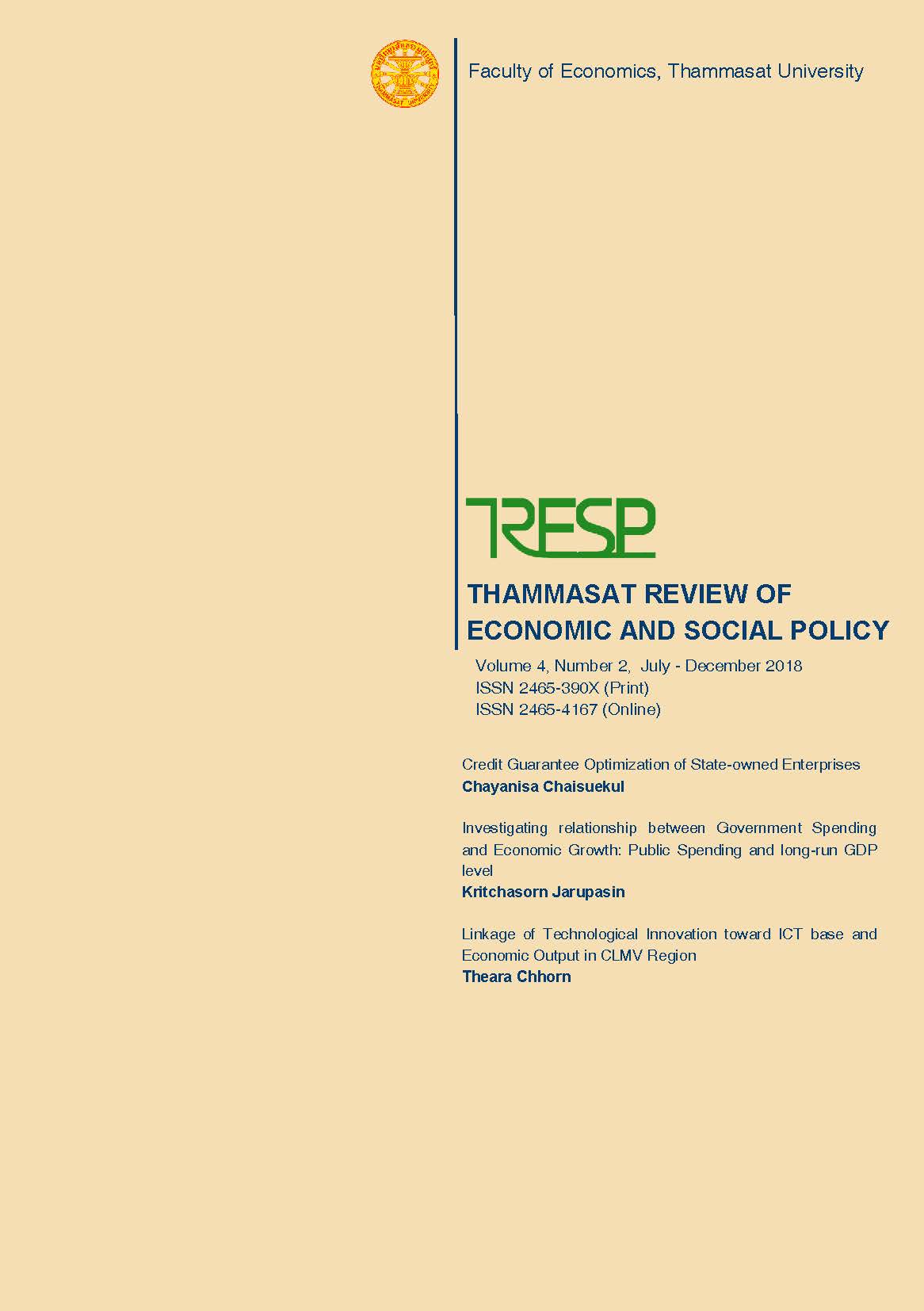Linkage of Technological Innovation toward ICT base and Economic Output in CLMV Region
DOI:
https://doi.org/10.14456/tresp.2018.6Keywords:
Technological Innovation and Progress, Economic Output, Economic Significance Analysis, CLMV RegionAbstract
The Fourth Industrial Revolution will change not only what we do but also who we are. It will affect our identity and all the issues associated with it (Schwab, 2016). The state of rising technological innovation and progress of the ICT-based era of modernization and globalization, particularly in developing countries, is driving the global economy into a new structure of transitional development and transformation. The paper examines the impacts of technological progress on economic output in the CLMV region from 1995 to 2016. The conventional estimation approaches of RE, MLE-RE, FE and FGLS estimation with/without robust standard error, provide accurate and consistent empirical outcomes. The crucial impact of technological progress, internet server connections and ICT and computer import products as proxies, is found to boost economic output and generate growth rate in the CLMV region. The findings suggest that policymakers should direct policy towards investment, trade in technology, and diversification to facilitate flows of capital, goods, and services, and support bringing business structures in line with technological innovation.
References
Adak, M. (2015). Technological Progress, Innovation and Economic Growth; the Case of Turkey. Procedia - Social and Behavioral Sciences, 195, 776–782. https://doi.org/10.1016/j.sbspro.2015.06.478
Alani, J. (2012). Effects of Technological Progress and Productivity on Economic Growth in Uganda. Procedia Economics and Finance, 1, 14–23. https://doi.org/10.1016/S2212-5671(12)00004-4
Baltagi, B. (2008). Econometric analysis of panel data. John Wiley & Sons.
Çalışkan, H. K. (2015). Technological change and economic growth. Procedia-Social and Behavioral Sciences, 195, 649–654.
Das, A., Khan, S., & Chowdhury, M. (2016). Effects of ICT Development on Economic Growth in Emerging Asian Countries. In B. Dey, K. Sorour, & R. Filieri (Eds.), ICTs in Developing Countries: Research, Practices and Policy Implications (pp. 141–159). London: Palgrave Macmillan UK. https://doi.org/10.1057/9781137469502_9
Kemp, S. (2017). Digital in Southeast Asia in 2017. We Are Social. Retrieved from https://wearesocial.com/specialreports/digital-southeast-asia-2017
Edquist, H., & Henrekson, M. (2006). Technological Breakthroughs and Productivity Growth. SSE/EFI Working Paper Series in Economics and Finance No. 0562. Stockholm School of Economics. Retrieved from https://ideas.repec.org/p/hhs/hastef/0562.html
Estrada, G. (2010). Financial Development and Economic Growth in Developing Asia. Asian Development Bank. Retrieved from https://www.adb.org/publications/financialdevelopment-and-economic-growth-developing-asia
Falk, M., & Biagi, F. (2015). Empirical studies on the impacts of ICT usage in Europe. Institute for Prospective Technological Studies Digital Economy Working Paper, 14.
Farhadi, M., Ismail, R., & Fooladi, M. (2012). Information and communication technology use and economic growth. PloS One, 7(11), e48903.
Gottfries, N. (2013). Macroeconomics (1st ed.). Basingstoke: Palgrave Macmillan.
Greene, W.H. (2012). Econometric Analysis. Pearson Education Limited.
Hagsten, E. (2016). Broadband connected employees and labour productivity: a comparative analysis of 14 European countries based on distributed Microdata access. Economics of Innovation and New Technology, 25(6), 613–629.
Hanclova, J., Doucek, P., Fischer, J., & Vltavska, K. (2015). Does ICT capital affect economic growth in the EU-15 and EU-12 countries? Journal of Business Economics and Management, 16(2), 387–406.
Hausman, J. (1978). Specification Tests in Econometrics. Econometrica, 46(6), 1251–1271.
Hsiao, C. (2014). Analysis of panel data. Cambridge University Press.
Imbens, G. W., & Wooldridge, J. M. (2009). Recent developments in the econometrics of program evaluation. Journal of Economic Literature, 47(1), 5– 86.
International Telecommunication Union (2014). Measuring the Information Society Report. Geneva: International Telecommunications Union.
Kuppusamy, M., Raman, M., & Lee, G. (2009). Whose ICT investment matters to economic growth: private or public? The Malaysian perspective. The Electronic Journal of Information Systems in Developing Countries, 37(1), 1–19.
Liljevern, J., & Karlsson, E. (2017). ICT Investment and the Effect on Economic Growth: A Comparative Study across Four Income Groups. Student Thesis. Jönköping University.
Manning, W. G. (1998). The logged dependent variable, heteroscedasticity, and the retransformation problem. Journal of Health Economics, 17(3), 283–295.
Mefteh, H. & Benhassen, L. (2015). Impact of Information Technology and Communication on Economic Growth. International Journal of Economics, Finance and Management, 4(2), 90-98.
Niebel, T. (2014). ICT and Economic Growth-Comparing Developing, Emerging and Developed Countries. IARIW 33rd General Conference. Rotterdam, the Netherlands.
Romer, P. M. (1990). Endogenous Technological Change. Journal of Political Economy, October.
Saidi, K., Hassen, L. B., & Hammami, M. S. (2015). Econometric analysis of the relationship between ICT and economic growth in Tunisia. Journal of the Knowledge Economy, 6(4), 1191–1206.
Samimi, A. J., Ledary, R. B., & Samimi, M. H. J. (2015). ICT & Economic Growth: A Comparison Between Developed & Developing Countries. International Journal of Life Science and Engineering, 1(1), 26–32.
Sassi, S., & Goaied, M. (2013). Financial development, ICT diffusion and economic growth: Lessons from MENA region. Telecommunications Policy, 37(4–5), 252–261.
Shahiduzzaman, M., & Alam, K. (2014). The long-run impact of Information and Communication Technology on economic output: The case of Australia. Telecommunications Policy, 38(7), 623–633.
Śledzik, K. (2013). Schumpeter’s view on innovation and entrepreneurship. Management Trends in Theory and Practice. University of Zilina & Institute of Management.
Solow, R. M. (1956). A contribution to the theory of economic growth. The Quarterly Journal of Economics, 70(1), 65–94.
Schwab, K. (2016). The Fourth Industrial Revolution: what it means and how to respond. World Economic Forum. Retrieved from https://www.weforum.org/agenda/2016/01/the-fourthindustrial-revolution-what-it-means-and-how-torespond/
Schumpeter, J. A. (1983). The Theory of Economic Development: An Inquiry into Profits, Capital, Credit, Interest, and the Business Cycle. Cambridge, Mass: Harvard University Press.
Vu, K. (2005). Measuring the Impact of ICT Investments on Economic Growth. Journal of Economic Growth.
Waverman, L., Meschi, M., & Fuss, M. (2005). The impact of telecoms on economic growth in developing countries. The Vodafone Policy Paper Series, 2(03), 10–24.



